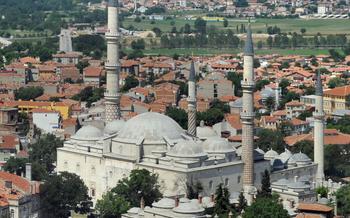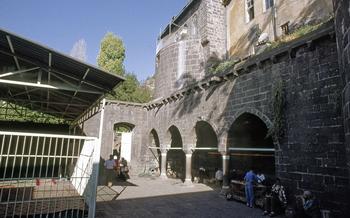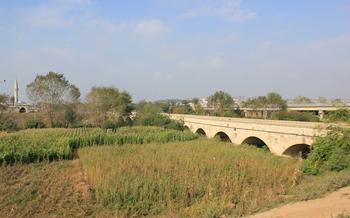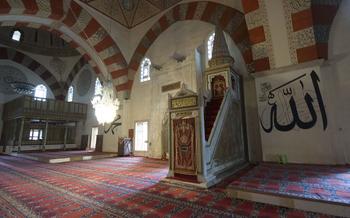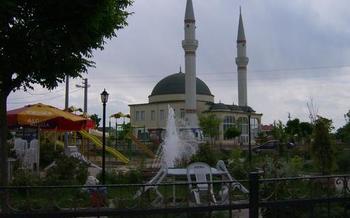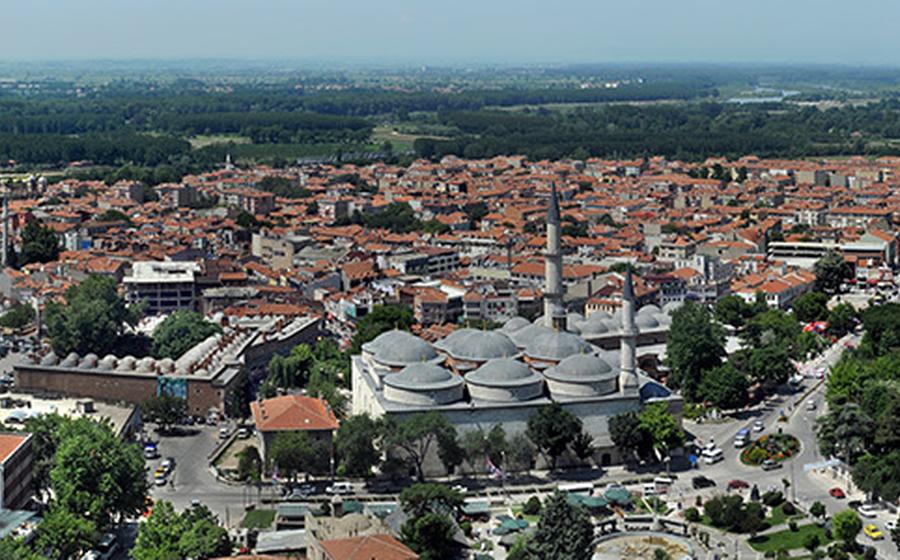
Eski Imaret Mosque
- The Eski Imaret Mosque: A Timeless Masterpiece
- Location and Accessibility
- Architectural Highlights
- The Courtyard and Ablution Fountain
- The Prayer Hall: A Place of Tranquility
- The Mihrab and Minbar: Symbols of Guidance
- The Minaret: A Call to Prayer
- Historical Significance
- The Mosque's Legacy
- Visiting the Eski Imaret Mosque: A Sacred Space
- Guided Tours and Information
- Photography and Videography
- Nearby Attractions and Activities
- Suggested Itineraries: Exploring Edirne's Treasures
- Insider Tip: Unveiling Hidden Gems
The Eski Imaret Mosque: A Timeless Masterpiece
The Eski Imaret Mosque, also known as the Old Imaret Mosque, stands as a testament to the rich history and architectural brilliance of the Ottoman Empire. Built in the 15th century, the mosque boasts a combination of Seljuk and Ottoman architectural styles, reflecting the transition between two significant eras in Turkish history. It holds immense historical and spiritual significance as one of the oldest and most revered mosques in Edirne, a city that once served as the capital of the Ottoman Empire.
The mosque's striking exterior, adorned with intricate carvings and decorative elements, captivates visitors. Its interior, featuring an awe-inspiring prayer hall with elegant columns, vaulted ceilings, and elaborate calligraphy, creates an atmosphere of serenity and devotion. The Eski Imaret Mosque is not just a place of worship; it is a symbol of resilience, cultural heritage, and the enduring legacy of the Ottoman Empire.
Location and Accessibility
The Eski Imaret Mosque stands majestically in the heart of Edirne, a city brimming with historical and cultural treasures. Situated in the historic quarter, the mosque's exact address is Imaret Mahallesi, Kurabiye Sokak No: Reaching the mosque is a breeze, as it is conveniently located within walking distance of many of the city's main attractions.
Once you arrive in Edirne, you can opt to explore the city on foot, immersing yourself in its vibrant atmosphere and admiring the architectural marvels that line its streets. Alternatively, you can take advantage of the city's efficient public transportation system, which offers a range of buses and trams that can take you to the mosque's doorstep.
If you prefer the convenience of driving, ample parking spaces are available in the vicinity of the mosque, ensuring a hassle-free visit. No matter your preferred mode of transportation, getting to the Eski Imaret Mosque is effortless, allowing you to delve into its captivating history and architectural splendor without any obstacles.
Architectural Highlights
The Eski Imaret Mosque stands as a testament to the architectural prowess of the Ottoman Empire. Its exterior facade is adorned with intricate carvings and decorative tilework, showcasing the artistry and attention to detail that characterize Islamic architecture. The entrance to the mosque is framed by a grand archway, inviting visitors into a realm of tranquility and spirituality.
Stepping inside the mosque, one is immediately struck by the vastness of the prayer hall and the intricate details that adorn its interior. The walls are adorned with verses from the Quran, inscribed in beautiful calligraphy, adding a sacred ambiance to the space. The ceiling is supported by rows of elegant pillars, each with unique carvings and patterns that contribute to the overall grandeur of the mosque.
Among the most notable architectural elements of the Eski Imaret Mosque is its mihrab, a niche in the wall that indicates the direction of Mecca. The mihrab is elaborately decorated with intricate tilework and carvings, creating a focal point for prayer and contemplation. The minbar, or pulpit, is another significant architectural feature, used by the imam to deliver sermons and religious teachings. It is beautifully crafted from wood and adorned with intricate carvings, highlighting the importance of religious discourse in Islamic tradition.
The Courtyard and Ablution Fountain
The courtyard, an integral part of Islamic architecture, serves as a transition space between the worldly realm and the sacred interior of the mosque. In the Eski Imaret Mosque, the courtyard is a serene and welcoming space, providing a sense of tranquility and preparation for prayer.
At the center of the courtyard, a striking ablution fountain stands as a testament to the importance of purification rituals in Islam. The fountain, intricately carved with geometric patterns and floral motifs, features multiple taps that allow worshippers to perform the prescribed ablutions before entering the prayer hall.
The act of ablution, known as wudu, holds deep spiritual significance in Islam. It symbolizes the cleansing of both the body and soul, preparing the worshipper for the sacred act of prayer. The water flowing from the fountain represents the purity and renewal that comes with this ritual.
Beyond its practical function, the courtyard also serves as a gathering place for the community. During festivals and special occasions, the courtyard transforms into a vibrant space, hosting religious ceremonies, celebrations, and community events. It fosters a sense of togetherness and reinforces the mosque's role as a social and cultural hub.
The Prayer Hall: A Place of Tranquility
Stepping into the prayer hall of the Eski Imaret Mosque is like entering a realm of serenity and devotion. The spacious chamber is designed to accommodate a large congregation, with rows of plush carpets covering the floor, inviting worshippers to immerse themselves in prayer. The walls are adorned with intricate tilework and calligraphy, creating a mesmerizing visual tapestry that enhances the spiritual atmosphere.
The focal point of the prayer hall is the mihrab, a niche in the wall that indicates the direction of Mecca, the holiest city in Islam. The mihrab is adorned with exquisite carvings and colorful tiles, serving as a symbol of guidance and devotion. The minbar, a raised platform used by the imam to deliver sermons, stands to the right of the mihrab, its intricate woodwork and elegant design adding to the overall grandeur of the space.
Natural light floods the prayer hall through the large windows, casting a warm glow that illuminates the intricate details of the interior. The soft murmur of prayers and the gentle rustling of prayer beads create a symphony of tranquility, conducive to deep contemplation and spiritual connection.
The Mihrab and Minbar: Symbols of Guidance
The mihrab, a niche in the wall of a mosque indicating the direction of Mecca, is a focal point of the Eski Imaret Mosque. Intricately adorned with tilework and calligraphy, it serves as a visual reminder of the importance of prayer in Islamic tradition. The minbar, a raised platform used by the imam to deliver sermons, stands adjacent to the mihrab. Its ornate design and carvings symbolize the authority and guidance of religious leaders. Together, the mihrab and minbar create a sense of reverence and spirituality within the prayer hall.
The Minaret: A Call to Prayer
The minaret of the Eski Imaret Mosque, a slender and graceful structure, stands tall against the skyline of Edirne. Symbolically, the minaret serves as a beacon of guidance, beckoning the faithful to prayer and connecting them with the divine. Its height and strategic placement ensure that the call to prayer, issued by the muezzin from the minaret's balcony, reverberates far and wide, echoing through the city's streets and reaching the ears of the devout.
The minaret's intricate design, adorned with decorative bands and motifs, reflects the exquisite craftsmanship of the mosque's builders. Its cylindrical form tapers gradually towards the top, creating a sense of dynamism and height. The minaret's crown, adorned with a delicate muqarnas frieze and a small dome, adds an element of lightness and elegance to the structure.
The role of the muezzin in Islamic tradition is of great significance. The muezzin's melodious voice, carrying the sacred words of the adhan (call to prayer), invites the faithful to gather for prayer and reminds them of their religious obligations. The adhan, echoing through the city's streets at dawn, noon, afternoon, sunset, and night, serves as a powerful reminder of the presence of Islam in Edirne.
Historical Significance
The Eski Imaret Mosque holds immense historical significance as it played a pivotal role during the Ottoman Empire. Built in the 15th century, it served as a religious and social center for the Ottoman community in Edirne. The mosque's grand architecture and intricate designs reflect the power and prosperity of the Ottoman Empire during its reign.
Its association with important historical figures further adds to its significance. It is believed that the mosque was commissioned by Sultan Murad II, one of the most prominent rulers of the Ottoman Empire. The mosque's construction and maintenance were overseen by architect Mimar Sinan, a renowned figure in Ottoman architecture. These associations with influential figures highlight the mosque's importance in the empire's history.
The Eski Imaret Mosque's enduring legacy is intertwined with the cultural heritage of Edirne. It has stood witness to the city's transformation over the centuries, serving as a place of worship, a center for Islamic learning, and a symbol of the city's rich Islamic heritage. Its continuous presence and significance make it an indispensable part of Edirne's cultural and historical narrative.
The Mosque's Legacy
The Eski Imaret Mosque has stood as a beacon of faith and a symbol of Edirne's rich cultural heritage for centuries. Its enduring significance extends far beyond its architectural beauty. The mosque has served as a center of learning, fostering religious education and scholarship. Throughout history, renowned Islamic scholars and theologians have graced its halls, imparting knowledge and guiding the community's spiritual growth.
Moreover, the mosque has played a vital role in preserving and promoting religious tolerance and understanding. As a place of worship open to all, it has fostered a spirit of harmony and coexistence among diverse faiths. The mosque's inclusive nature has contributed to Edirne's reputation as a city where different religions and cultures can flourish side by side.
The Eski Imaret Mosque's legacy extends beyond its physical structure. It has become an integral part of the city's cultural identity and a source of pride for the local community. Its presence has helped shape the city's unique character and continues to inspire and uplift generations of Edirne residents and visitors alike.
Visiting the Eski Imaret Mosque: A Sacred Space
As you approach the Eski Imaret Mosque, remember that you are entering a sacred space that demands respectful behavior and appropriate attire. While the mosque welcomes visitors from all backgrounds, it is essential to observe certain customs and etiquette. Modest clothing that covers your shoulders and knees is recommended, and removing shoes before entering the prayer hall is customary.
For non-Muslims, it is important to be mindful of the religious significance of the mosque and avoid any actions that may be perceived as disrespectful. While photography and videography are permitted in designated areas, it is crucial to be discreet and avoid disturbing worshippers.
To fully appreciate the tranquility and spirituality of the mosque, consider visiting during non-prayer times. This will allow you to explore the mosque at your own pace, admire its architectural details, and soak in the serene atmosphere without causing any disruptions.
Guided Tours and Information
To enhance your visit to the Eski Imaret Mosque, consider joining a guided tour. Knowledgeable guides, often fluent in multiple languages, provide insightful commentary on the mosque's history, architecture, and significance. They can point out intricate details and symbolism that you might otherwise miss. Guided tours are typically offered at various times throughout the day, and you can inquire about availability at the visitor center or information booth.
If you prefer a self-guided tour, brochures and printed materials are available to help you explore the mosque at your own pace. These materials often include maps, historical background, and descriptions of the mosque's features. Remember to take your time and soak in the beauty and tranquility of this sacred space.
Photography and Videography
Capturing the beauty of the Eski Imaret Mosque through photography or videography is a wonderful way to preserve your memories and share them with others. However, it is important to be respectful of the sanctity of the religious space and to adhere to the following guidelines:
-
Permitted Areas: Photography and videography are generally permitted in the courtyard, exterior of the mosque, and in designated areas within the prayer hall. However, it is important to avoid taking photos or videos of individuals praying or engaged in religious rituals without their consent.
-
Respectful Behavior: Remember that the mosque is a place of worship, and it is essential to maintain a respectful demeanor while taking photos or videos. Avoid using flash photography, as it can be disruptive to those praying. Additionally, be mindful of noise levels and keep your voice low.
-
Composition Tips: To capture the best shots, consider using a wide-angle lens to capture the grandeur of the mosque's architecture. Pay attention to lighting conditions, as the mosque's beauty can be enhanced by the warm glow of sunrise or sunset. Experiment with different angles and perspectives to create unique and visually appealing compositions.
Nearby Attractions and Activities
The Eski Imaret Mosque stands as a beacon of history and spirituality, yet its surroundings offer a wealth of additional experiences. Just a short stroll away, visitors can immerse themselves in the bustling energy of the city center, with its vibrant bazaars, charming cafes, and traditional restaurants. History buffs will delight in exploring the nearby Edirne Museum, showcasing the rich cultural heritage of the region.
For those seeking a tranquil retreat, the serene banks of the Meriç River provide a picturesque setting for leisurely walks or picnics. Nature enthusiasts can venture further afield to the breathtaking Uzunköprü Bridge, an architectural marvel spanning the river with its graceful arches.
Edirne is also renowned for its vibrant festivals and cultural events. The annual Kırkpınar Oil Wrestling Festival, held in July, is a spectacle of strength and tradition, attracting participants and spectators from far and wide. The city also hosts regular art exhibitions, concerts, and performances, offering a glimpse into the diverse talents of the local community.
Suggested Itineraries: Exploring Edirne's Treasures
To fully experience the charm of Edirne, consider dedicating a half-day or a full day to exploring its historical and cultural landmarks. Here are some suggested itineraries:
Half-Day Itinerary:
- Start your morning with a visit to the Eski Imaret Mosque, marveling at its architectural grandeur and spiritual significance.
- Stroll through the vibrant streets of Edirne, soaking in the local atmosphere and discovering hidden gems.
- Visit the Selimiye Mosque, a UNESCO World Heritage Site, and admire its stunning architecture and exquisite tilework.
- Take a leisurely break at one of the traditional Turkish restaurants, savoring the flavors of local cuisine.
For a more comprehensive experience, extend your stay to a full day:
Full-Day Itinerary:
- Begin your day with a visit to the Eski Imaret Mosque, immersing yourself in its rich history and spiritual essence.
- Explore the Edirne Museum, which houses a fascinating collection of artifacts and exhibits showcasing the city's past.
- Visit the Üç Şerefeli Mosque, renowned for its unique architectural features and historical significance.
- Indulge in a traditional Turkish bath experience at one of the many hamams, rejuvenating your body and mind.
- In the evening, stroll along the banks of the Tunca River, enjoying the serene atmosphere and picturesque views.
If you're pressed for time, opt for a personalized itinerary tailored to your interests. Whether you're a history buff, an architecture enthusiast, or a culinary explorer, Edirne has something to offer everyone. Local guides can provide valuable insights and recommendations to ensure you make the most of your visit.
Insider Tip: Unveiling Hidden Gems
Beyond the main attractions, the Eski Imaret Mosque holds several hidden gems that offer unique perspectives and insights. One such gem is the mosque's intricate tilework. While the exterior facade may appear simple, the interior walls are adorned with exquisite tile panels that showcase a vibrant array of colors and patterns. Each tile is meticulously hand-painted, narrating stories from Islamic history and culture.
Another hidden gem lies within the mosque's courtyard. Amidst the serene atmosphere, visitors can discover a concealed fountain adorned with intricate carvings and inscriptions. This fountain, often overlooked by many, holds symbolic significance in the purification rituals performed before prayer. Its elegant design and flowing water create a sense of tranquility and spiritual cleansing.
For those seeking a deeper connection with the mosque's history, the caretaker's quarters offer a glimpse into the daily lives of those who have served the mosque over the centuries. These modest rooms, tucked away in a corner of the complex, provide a unique opportunity to understand the dedication and devotion of the mosque's caretakers.
These hidden gems, often missed by casual visitors, reveal the Eski Imaret Mosque's rich tapestry of history, art, and spirituality. They invite travelers to explore beyond the surface and discover the hidden treasures that make this mosque a truly remarkable destination.
